This article needs additional citations for verification .(September 2011) |
| Country of origin | Czechoslovakia |
|---|---|
The Czechoslovakian Small Riding Pony is a breed of pony, used as a riding animal for children.
This article needs additional citations for verification .(September 2011) |
| Country of origin | Czechoslovakia |
|---|---|
The Czechoslovakian Small Riding Pony is a breed of pony, used as a riding animal for children.
Development of this small riding pony began in 1980 at the Agricultural University in Nitra. The initial breeding stock, about seventy mares, were kept at the Nová Bana farm.
Broodmares were selected mostly of Arabian stock and also included Hanoverian, Slovak Warmblood and Hucul. A herd of twenty-seven mares averaging 14.2 hands were selected for the first crosses to a Welsh pony stallion, Branco. The first offspring, foaled in 1981, were kept outdoors on the rough terrain. Additional crosses were made to another Welsh stallion, Shal, imported from West Germany. The first foals were trained under saddle and in harness in 1984 and nearly all successfully passed the working trials. Animals of the new breed are docile, with an alert but calm temperament, modest in feeding requirement and effective in utilization of food. They have good gaits and jumping ability. They stand between 13.2 and 13.3 hands high.
In 1989 a conference was held at the Agricultural University of Nitra regarding the breeding programme. It was agreed that methods being used to breed a small sport horse for children from the ages of eight to sixteen years were correct and that efforts should be continued.
There are now over 150 of these new breed of ponies, and plans are being made to establish a club for private breeders of small horses in Nitra.

Horse breeding is reproduction in horses, and particularly the human-directed process of selective breeding of animals, particularly purebred horses of a given breed. Planned matings can be used to produce specifically desired characteristics in domesticated horses. Furthermore, modern breeding management and technologies can increase the rate of conception, a healthy pregnancy, and successful foaling.

The Morgan horse is one of the earliest horse breeds developed in the United States. Tracing back to the foundation sire Figure, later named Justin Morgan after his best-known owner, as well as mares of the now-extinct Narragansett Pacer breed, Morgans served many roles in 19th-century American history, being used as coach horses and for harness racing, as general riding animals, and as cavalry horses during the American Civil War on both sides of the conflict. Morgans have influenced other major American breeds, including the American Quarter Horse, the American Saddlebred, the Tennessee Walking Horse, and the Standardbred.

The Lipizzan or Lipizzaner is a European breed of riding horse developed in the Habsburg Empire in the sixteenth century. It is of Baroque type, and is powerful, slow to mature and long-lived; the coat is usually gray.

The Dartmoor Pony is a breed of pony that lives in Devon, England. The breed has been in England for centuries and is used in a variety of roles. Because of the extreme weather conditions experienced on the moors, the Dartmoor Pony is a particularly hardy breed with excellent stamina. Over the centuries, it has been used as a working animal by local tin miners and quarry workers. It is kept in a semiferal state on Dartmoor.
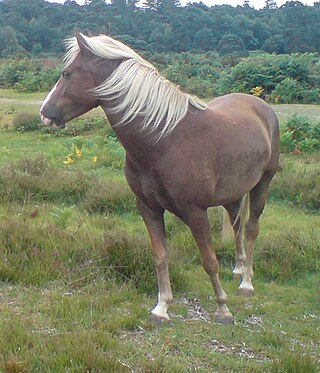
The New Forest pony is one of the recognised mountain and moorland or native pony breeds of the British Isles. Height varies from around 12 to 14.2 hands ; ponies of all heights should be strong, workmanlike, and of a good riding type. They are valued for hardiness, strength, and sure-footedness.

The Canadian is a horse breed from Canada. It is a strong, well-muscled horse, usually dark in colour. It is generally used for riding and driving. Descended from draft and light riding horses imported to Canada in the late 1600s from France, it was later crossed with other British and American breeds. During the 18th century the Canadian horse spread throughout the northeastern US, where it contributed to the development of several horse breeds. During the peak popularity of the breed, three subtypes could be distinguished, a draft horse type, a trotting type and a pacing type. Thousands of horses were exported in the 19th century, many of whom were subsequently killed while acting as cavalry horses in the American Civil War. These exports decreased the purebred Canadian population almost to the point of extinction, prompting the formation of a studbook and the passage of a law against further export.

The Dales Pony is a British breed of pony or small horse. It originated in, and is named for, the Dales of Yorkshire in northern England. It is one the nine native mountain and moorland pony breeds of the United Kingdom, and belongs to the broader Celtic group of ponies which extends from Portugal and northern Spain to Scandinavia.

The Dole Gudbrandsdal, Dølahest, or Dole is a draft- and harness-type horse from Norway. The Dole Trotter is alternately considered a subtype of the Dole Gudbrandsdal and a separate breed; it is also considered a part of the coldblood trotter type. The Dole Gudbrandsdal is a small draft horse, known for its pulling power and agility, while the Dole Trotter is a smaller, faster horse used for harness racing; the two types are commonly interbred. Both types are strictly critiqued before entry into the studbook, which has over time resulted in an improvement in the breed type. The Dole is originally from the Gudbrandsdal Valley, and is probably descended in part from the Friesian horse. Over time, the breed has had Thoroughbred, Arabian, and other breeds added in, especially during the creation of the Dole Trotter in the 19th century. The first studbook was created in 1941, and the current breed association was formed in 1947. Although originally used mainly as a pack horse, today, the heavier Dole type is used mainly for agricultural purposes. The Dole Gudbrandsdal been crossed with other breeds to develop horses for harness racing and riding.
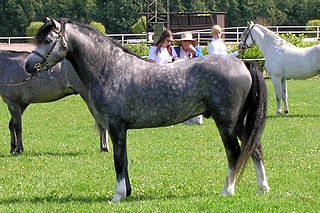
The Welsh Pony and Cob is a group of four closely-related horse breeds including both pony and cob types, which originated in Wales. The four sections within the breed society for the Welsh breeds are primarily distinguished by height, and also by variations in type: the smallest Welsh Mountain Pony ; the slightly taller but refined Welsh Pony of riding type popular as a children's show mount; the small but stocky Welsh Pony of Cob Type, popular for riding and competitive driving; and the tallest, the Welsh Cob, which can be ridden by adults. Welsh ponies and cobs in all sections are known for their good temperament, hardiness, and free-moving gaits.
The Welara is a part-Arabian pony breed developed from the Arabian horse and the Welsh pony. It was originally bred in England by Lady Wentworth at the Crabbet Arabian Stud in the early 1900s from imported Arabian stallions and Welsh pony mares. Breeding then spread throughout North America. In 1981, a breed registry was formed in the United States, and a studbook began to be published. They are used for many disciplines of English riding, and are known for their refinement, hardiness and spirit.
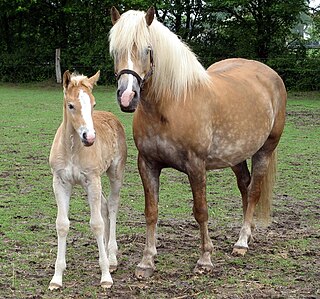
The Haflinger, also known as the Avelignese, is a breed of horse developed in Austria and northern Italy during the late 19th century. Haflinger horses are relatively small, are always chestnut with flaxen mane and tail, have distinctive gaits described as energetic but smooth, and are well-muscled yet elegant. The breed traces its ancestry to the Middle Ages; several theories for its origin exist. Haflingers, developed for use in mountainous terrain, are known for their hardiness. Their current conformation and appearance are the result of infusions of bloodlines from Arabian and various European breeds into the original native Tyrolean ponies. The foundation sire, 249 Folie, was born in 1874; by 1904, the first breeders' cooperative was formed. All Haflingers can trace their lineage back to Folie through one of seven bloodlines. World Wars I and II, as well as the Great Depression, had a detrimental effect on the breed, and lower-quality animals were used at times to save the breed from extinction. During World War II, breeders focused on horses that were shorter and more draft-like, favored by the military for use as packhorses. The emphasis after the war shifted toward animals of increased refinement and height.
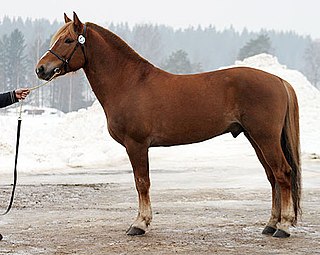
The Finnhorse or Finnish Horse is a horse breed with both riding horse and draught horse influences and characteristics, and is the only breed developed fully in Finland. In English it is sometimes called the Finnish Universal, as the Finns consider the breed capable of fulfilling all of Finland's horse needs, including agricultural and forestry work, harness racing, and riding. In 2007, the breed was declared the official national horse breed of Finland.

The Lundy Pony is a British breed of pony bred on Lundy Island in the twentieth century.
The American Walking Pony is a modern American breed of gaited riding pony. It was created by crossbreeding of the Tennessee Walking Horse and the Welsh Pony. Originally developed in Georgia, the breed was established in 1968 after several years of selective breeding. Joan Hudson Brown is credited as the founder of the breed and was the first executive secretary of the breed registry. The original breeding goal was to combine the smooth gait of the Tennessee Walker with the small size and refinement of the Welsh pony. Any combination of the two breeds is acceptable for the registry.
The Virginia Highlander is a small breed of horse with a four-beat ambling gait. It stands between 13 and 14 hands high. Coat colors include roan, chestnut, black and gray, and the occasional white. Breed characteristics include a good temperament and a natural singlefoot gait.

The Deutsche Reitpony or German Riding Pony is a very popular pony breed in Germany. It is described as a "miniature warmblood" with refined, horse-like characteristics that make it suitable as both a children's pony and as a mount for sport horse competition in Europe. Originally bred in Germany and later throughout Western Europe, the breed is relatively new to North America.

Mountain and moorland ponies form a group of several breeds of ponies and small horses native to the British Isles. Many of these breeds are derived from semi-feral ponies kept on moorland or heathland, and some of them still live in this way, as well as being kept as fully domesticated horses for riding, driving, and other draught work, or for horse showing.

The Heck horse is a horse breed that is claimed to resemble the tarpan, an extinct wild equine. The breed was created by the German zoologist brothers Heinz Heck and Lutz Heck in an attempt to breed back the tarpan. Although unsuccessful at creating a genetic copy of the extinct species, they developed a breed with grullo coloration and primitive markings. Heck horses were subsequently exported to the United States, where a breed association was created in the 1960s.
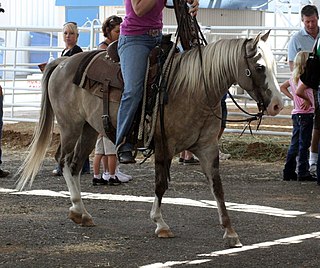
The Quarter Pony is a breed of pony that is similar to the American Quarter Horse. It stands up to 14.2 hands high and was developed from American Quarter Horse foundation bloodstock. The breed was originally developed from Quarter Horses that did not meet the American Quarter Horse Association's height requirement. It is bred to look like a small Quarter Horse, although the various registries also allow crosses with other breeds, including Paint horse, Appaloosa and Pony of the Americas, all stock types. It is one of the most versatile horse breeds there are. There are three registries for the Quarter Pony, all with slightly different registration requirements. The first registry was begun in 1964, and two more were started in the 1970s. The breed is used today in a variety of Western and English riding disciplines.

The Lac La Croix Indian Pony (LLCIP), also known as the Ojibwe pony is a semi-feral Canadian horse breed developed by the Ojibwe people. The population became critically low; and, by 1977, only four mares remained. To preserve the breed, these mares were crossed with Spanish Mustang stallions. The modern breed name derives from the Lac La Croix First Nation of Ontario, where the horses were last found in the wild. Historically, the breed was also found in Minnesota.